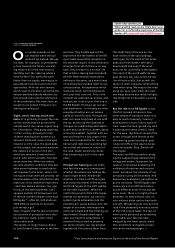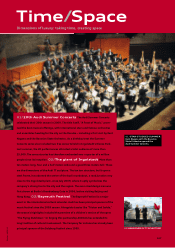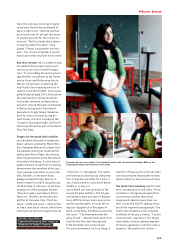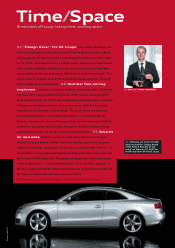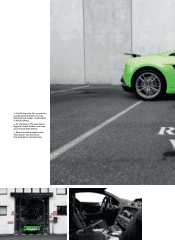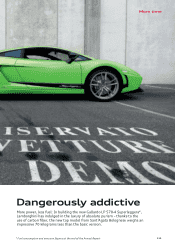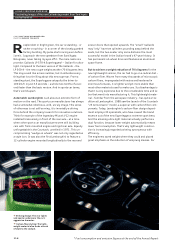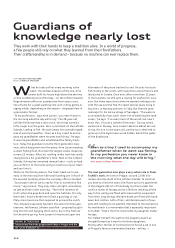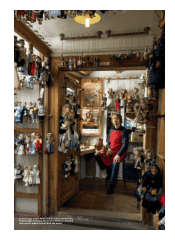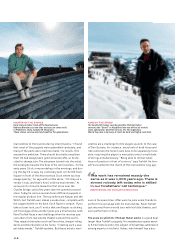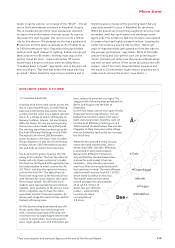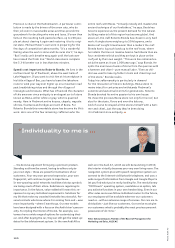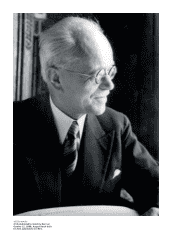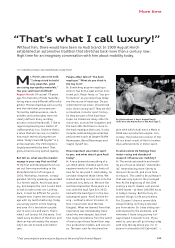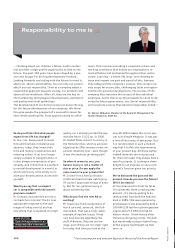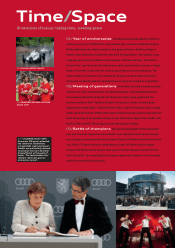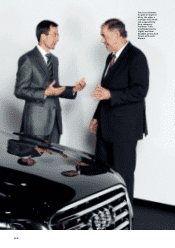Audi 2009 Annual Report Download - page 119
Download and view the complete annual report
Please find page 119 of the 2009 Audi annual report below. You can navigate through the pages in the report by either clicking on the pages listed below, or by using the keyword search tool below to find specific information within the annual report.
hat he looks at first every morning is the
water, the endless expanse of the sea. Arne
Larsen built his house high above the skerries
on the northwest point of Norway – on the Lofoten Islands.
Huge windows afford an outside view from every room,
like a frame for a great painting: the surf, rolling gently or
raging wildly, depending on the season – displayed here in
a panoramic format.
“In my profession,” says Arne Larsen, “you never know in
the morning what the day will bring.” The 38-year-old
Lofoten fisherman has a calm voice, which has turned a
trifle rough over the years. He is a merchant on the Lofoten
Islands, trading in fish. His work keeps him outside regard-
less of wind and weather. “Even as a boy I used to accom-
pany my grandfather when he went sea fishing,” he says.
It was his grandfather who established the family tradi-
tion. Today the grandson runs the third-generation busi-
ness, which has grown over the years: Arne Larsen employs
a small fishing fleet. But even the largest vessel measures
a mere 22 meters. After all, nothing in this work has really
changed since his grandfather’s time: Here on the Lofoten
Islands, fishing has remained manual labor – a job so hard
you can feel it to the bones and you need to put your heart
and soul into it.
Winter is the fishing season. The boats head out to sea
early in the morning from the small landing pier in front of
the wooden building where the company office is located.
“Our people ride far out to sea for four or sometimes five
hours,” says Larson. They only return at night, sometimes
as late as three in the morning. “That’s the moment of
truth: when the guys dock and open the hatches. It’s only
then that I know whether we’ve had a good day or not.”
Many more hours are then required to process the catch.
The company’s specialty has been the same for three gen-
erations: the famous Lofoten stockfish – prepared by split-
ting the fish and hanging them out to dry in the fresh air
for the entire spring. Arne Larsen’s lines would span two
kilometers if they were tied end to end. He sells his stock-
fish mostly in the south, with customers around Venice and
lately also in Croatia. Even now, after more than 12 years
in the business, he still gets a craving for seafood on occa-
sion. But there was a time when he wanted nothing to do
with the sea and the fish. He spent several years living in
big cities, in Norway and even in Italy. But then he grew
nostalgic for his native village of Sørvågen. “The water is
so wonderfully clear, and I never tire of admiring the land-
scape,” he says. “I’ve seen much of the world, but now I
know this: I’m just a Lofoten fisherman.” During school
vacations in Norway, Arne Larsen takes his eldest son out
to sea. His son is nine years old, and he too is destined to
grow up in the mysterious world hidden behind the gates
of the boathouse.
The next generation also plays a very active role in Pavel
Truhlárˇ’s work. He lives in Prague, around 2,000 kilo-
meters directly south of the Lofoten Islands. To visit him
you have to climb the stairs five floors up to his apartment
in the elegant district of Vinohrady. Up there under the
roof is a realm of fantasy and art: Shelves reaching all the
way to the ceiling are filled with marionettes suspended
from their long strings. Wooden boxes are filled with hand-
sewn doll clothes, tufts of hair, and delicate parts of pup-
pets still needing to be painted. Mounted to the wall above
his workbench is a marionette that’s especially important
to Truhlárˇ: “That’s the first marionette my daughter made,”
he says.
For Truhlárˇ himself, the path to the puppets wasn’t as
straightforward as it was for his three daughters.
Shortly after the fall of Communism he found a job in one
of Prague’s famous marionette theaters – selling
116
COPY/KILIAN KIRCHGESSNER
PHOTOS/NIKOLA TACEVSKI
W
Guardians of
knowledge nearly lost
They work with their hands to keep a tradition alive: In a world of progress,
a few people still rely on what they learned from their forefathers.
Their craftsmanship is in demand – because no machine can ever replace them.
“
Even as a boy I used to accompany my
grandfather when he went sea fishing.
In my profession you never know in
the morning what the day will bring.”
Arne Larsen, Lofoten fisherman
BOUND BY TRADITION
Impressions from the puppet workshop in Prague and the
ski run at Kitzbühel at: w
wwwww..aauuddii..ccoomm//aarr22000099//ooccccuuppaattiioonnss


